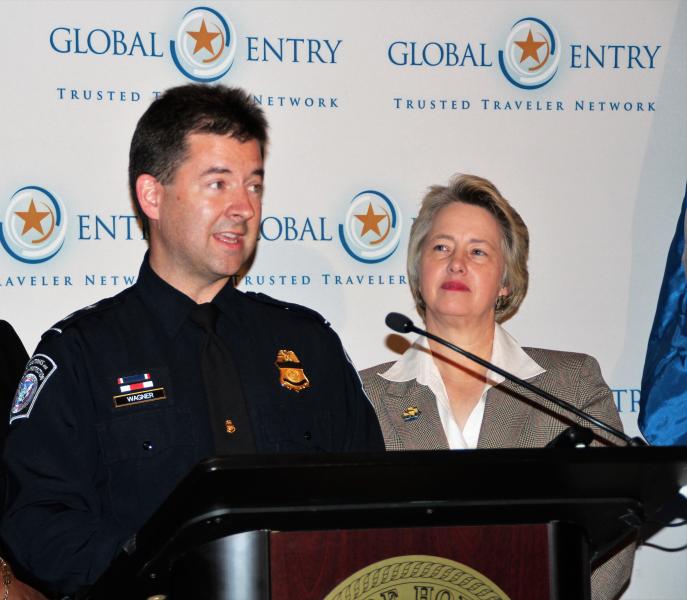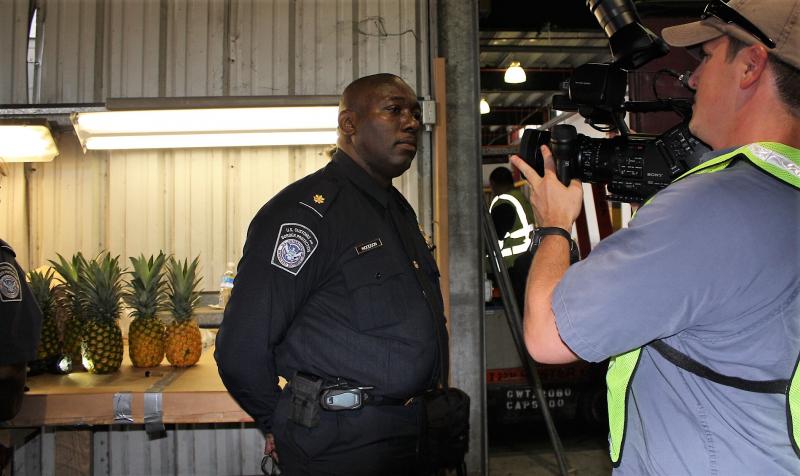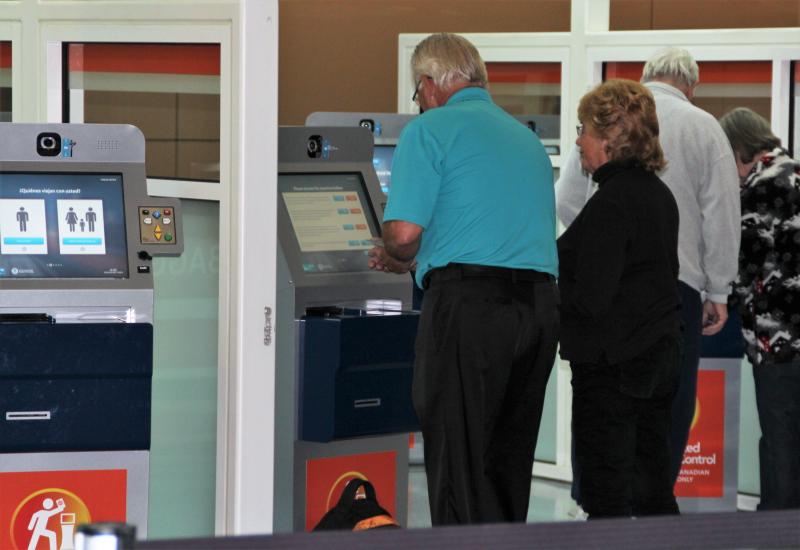Milestones Highlight Partnerships, Technology Advances
HOUSTON – Fifteen years ago, the Department of Homeland Security (DHS) became a Cabinet-level department to coordinate and oversee a national strategy to prevent terrorists and terrorist weapons from entering the United States.

Commissioner of Office of Field
Operations John Wagner makes
remarks at Houston's second Global
Entry Enrollment Center at City Hall
in 2013 while Houston Mayor Annise
Parker looks on.
Created after September 11, 2001, the move integrated 22 different federal departments and agencies, and unified efforts to secure the nation.
U.S. Customs and Border Protection (CBP) was initially formed by combining inspection and enforcement elements of the U.S. Customs Service, Immigration and Naturalization Service including the U.S. Border Patrol, and the U.S. Department of Agriculture Animal and Plant Health Inspection Service. In 2004, DHS transferred Air and Marine Operations to CBP where it became the agency’s experts in airborne and maritime law enforcement.
“It’s important to remember why our department was formed 15 years ago,” said Houston Director of Field Operations Judson W. Murdock II. “We were created to protect this nation from those who are determined to do us harm. Since our formation, we have remained vigilant day in and day out while continuing to facilitate international travel and trade.
"We have leveraged technology to improve our operations without compromising security. Using programs such Global Entry, Mobile Passport Control and Automated Passport Control kiosks are examples of how CBP has worked with airport authorities to bring technology to bear in this effort. We will continue to look for innovative solutions, partnerships and opportunities to disrupt criminal activity without disrupting international travel and trade,” Murdock said.
In 15 years, CBP has achieved major milestones toward protecting the nation while securing international trade and travel. Some highlights include implementing Global Entry at George Bush Intercontinental Airport in 2008, deploying the Unmanned Aircraft System in Corpus Christi, Texas in 2010, standing up the Petroleum, Natural Gas and Minerals Center of Expertise and Excellence in Houston in 2012 and joining the federal response to the Ebola outbreak in 2014.

Larry Woodson gives an interview
about the important work agriculture
specialists do in Freeport, Texas in 2009.
What follows are a few highlights of CBP’s endeavors to keeping America safe.
2003 – President George W. Bush proposed to create the Department of Homeland Security subsequently forming U.S. Customs and Border Protection.
2004 – DHS transfers Air and Marine Operations from U.S. Immigration and Customs Enforcement to CBP.
2005 – CBP’s Air and Marine Operations first deploys the Predator B to enhance law enforcement operations along the Southwest Border.
2006 – CBP unified its air and marine assets under the management of CBP’s Office of Air and Marine, the largest civilian law enforcement air force in the world, and broke ground on the National Air Training Center facility in Oklahoma City.
2007 – CBP established the National Targeting Center-Cargo to identify high-risk cargo shipments destined to the United States.
2008 – CBP launched Global Entry, at George Bush Intercontinental Airport to expedite processing for pre-approved, low-risk travelers. Today there are more 1.4 million Global Entry members.
2009 – CBP agriculture specialist in Freeport, Texas discovers a weevil previously unknown and not currently described in science databases. CBP’s agriculture specialists work at 167 ports of entry protecting U.S. agriculture industries by intercepting invasive insects and plants and foreign animal and plant diseases.

Dallas Fort Worth International Airport
allowing passengers to complete some
of the processing requirements at ports
of entry.
2010 – CBP begins UAS operations in Corpus Christi, Texas. CBP officers arrest the Times Square Bomber minutes before his international flight was to depart JFK.
2011 – CBP supports Super Bowl XLV in Arlington, Texas.
2012 – CBP introduced Centers of Excellence and Expertise, including the Petroleum, Natural Gas and Minerals located in Houston, to facilitate timely resolution of trade compliance issues nationwide. CEE’s trade experts help to identify and seize more than $1.2 billion in counterfeit consumer imports annually.
2013 – CBP began managing the Tethered Aerostat Radar System, capable of detecting aircraft at a range of 200 miles.
2014 – CBP joins federal response to Ebola outbreak, participates in Congressional field hearings in Dallas.
2015 –CBP scientist working in Houston provides pollen analysis leading to identification of Baby Doe and subsequent arrest of her murderer.
2016 – CBP returns to New York City’s One World Trade Center 15 years after September 11, 2001.2017 – CBP responds to support hurricane recovery operations in Texas, Florida and Puerto Rico following three category 4-5 hurricanes that resulted in nearly $300 billion in damages and more than 350 victims killed. CBP announces construction of border wall prototypes to achieve complete operational control of the nation’s southern border

by introducing facial recognition for
some flights departing George Bush
Intercontinental and William P. Hobby
airports in 2017.
2018 – CBP expands biometric entry/exit capabilities to international airports including both of Houston’s airports that fulfill a congressional mandate to keep America safe.
Today, CBP employs about 60,000 men and women who each day process more than 1 million passengers and pedestrians and $6.5 billion worth of imported goods arriving into the U.S. Agency employees collect more than $120 million in duties, taxes, and other fees.
Every day, CBP Field Operations officers, Air and Marine Operations agents, and U.S. Border Patrol agents serve on the frontline to stop the flow of illicit drugs into the country and bulk currency out of the country. They seize an average of 5,863 pounds of illicit narcotics each day, disrupt another 222 pounds of the deadly drugs, and seize $265,205 in undeclared or illicit currency daily.
They also stop $3.3 million worth of products with Intellectual Property Rights violations.
CBP agriculture specialists intercept 352 pests at U.S. ports of entry and 4,638 materials for quarantine of plant, meat and animal byproduct and soil.
View more of what CBP achieves on a “Typical Day.” Learn more about CBP at www.CBP.gov.


